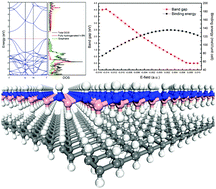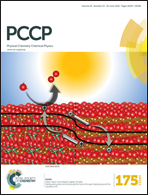Tuning the electronic properties and work functions of graphane/fully hydrogenated h-BN heterobilayers via heteronuclear dihydrogen bonding and electric field control†
Abstract
Using density functional theory calculations with van der Waals correction, we show that the electronic properties (band gap and carrier mobility) and work functions of graphane/fully hydrogenated hexagonal boron nitride (G/fHBN) heterobilayers can be favorably tuned via heteronuclear dihydrogen bonding (C–H⋯H–B and C–H⋯H–N) and an external electric field. Our results reveal that G/fHBN heterobilayers have different direct band gaps of ∼1.2 eV and ∼3.5 eV for C–H⋯H–B and C–H⋯H–N bonds, respectively. In particular, these band gaps can be effectively modulated by altering the direction and strength of the external electric field (E-field), and correspondingly exhibit a semiconductor–metal transition. The conformation and stability of G/fHBN heterobilayers show a strong dependence on the heteronuclear dihydrogen bonding. Fantastically, these bonds are stable enough under a considerable external E-field as compared with other van der Waals (vdW) 2D layered materials. The mobilities of G/fHBN heterobilayers we predicted are hole-dominated, reasonably high (improvable up to 200 cm2 V−1 s−1), and extremely isotropic. We also demonstrate that the work function of G/fHBN heterobilayers is very sensitive to the external E-field and is extremely low. These findings make G/fHBN heterobilayers very promising materials for field-effect transistors and light-emitting devices, and inspire more efforts in the development of 2D material systems using weak interlayer interactions and electric field control.


 Please wait while we load your content...
Please wait while we load your content...